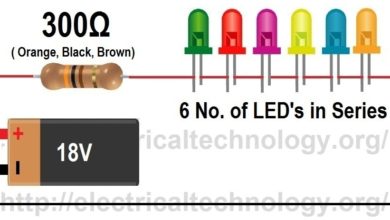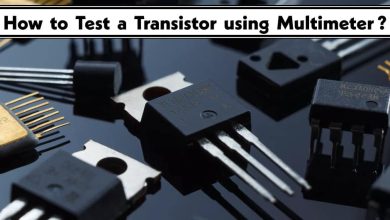Point Contact Diode – Working, Construction, and Applications
Point Contact Diode: It’s Symbol, Working, Construction, Characteristics, Advantages, Disadvantages and Applications
Diode is a semiconductor-based component that allows current in only one direction and blocks in other direction. It offers nearly zero resistance in one direction and very large resistance in the other direction. It has two terminals anode and a cathode.
There are different types of diodes used in electronic circuits. Point Contact Diode is a type of diode that is used for its very low capacitance resulting in a very high switching speed.
What is a Point Contact Diode?
Point Contact Diode is a type of Germanium diode that has a very high switching speed. It is made by connecting a metallic wire with an N-type semiconductor. As the wire touches the semiconductor at a very small point, the junction formed is very small and has very small capacitance. The charge storage at the junction is very small and as a result, it switches faster as compared to other diodes.
Since the metallic wire touches the N-type semiconductor at a small point, therefore it is named the point contact diode. It is also known as “Cat Whisker Diode” or “Crystal Diode” due to the thin springy nature of the wire like a cat’s whisker and the rectangular crystal semiconductor. Its operation depends on the pressure of the contact and the semiconductor crystal. It is used for microwave applications such as microwave receivers and mixers ranging from 1 to 30 gigahertz frequency.
Related Posts:
- What is Diode? Construction and Working of PN Junction Diode
- Types of Diodes and Their Applications – 24 Types of Diodes
Symbol
The symbol used for the point contact diode is the same as the generic diode symbol as shown below.
Construction of Point Contact Diode
The point contact diode is made of a thin metallic wire called a cat whisker and a small N-type silicon crystal of rectangular shape. The cat whisker is made of a fine wire of beryllium-copper, bronze-phosphor, or tungsten.
During the manufacturing of the diode, a large current is passed through the cat whisker that presses against the silicon crystal. The large current causes some atoms to pass from the whisker to the crystal surface resulting in the formation of a P-region upon the crystal at the point of contact. As the crystal is an N-type semiconductor, the resulting P-region upon it forms a PN junction. This small junction acts as a conventional PN junction.
Since the junction is formed at the point of contact of the tiny cat whisker, it is very small. This small junction has a very small capacitance that can store very small charges. The thin cat whisker is used instead of a flat metal because it can generate a high-intensity electric field at a small point. Also, a flat metal contact with a semiconductor junction is used in the Schottky barrier or Hot-carrier diode which is a modified version of a point contact diode.
The end of the cat whisker wire is connected to a metal post that acts as one of the terminals of the diode called the anode. While the N-type semiconductor crystal is placed on top of a flat metal post to form the other terminal called the cathode. The metal contacts allow low resistance connection with the external circuit. The entire structure is enclosed in a glass or ceramic structure.
Related Posts:
- Fast Recovery Diode: Construction, Working and Applications
- Step Recovery Diode – SRD: Construction, Working and Applications
Working and Operation
The working principle of the point contact diode is the same as any conventional PN junction diode except for its fast switching speed.
As we know a cat whisker (thin metallic wire) is placed on the surface of an N-type crystal. The other P-region is formed when a comparatively large current pass through the wire and it heats up forming a small P-region on the crystal. The length of the wire is deliberately left longer with a bend to compensate for the thermal expansion. The PN junction formed is very small and cannot be seen with the naked eye. It acts as any conventional PN junction.
As the size of the junction is very small, its capacitance is also small in the range of 0.1 to 1 pF. On top of that, to further reduce the capacitance, the smaller P-region reduces the charge storage of minority carriers. Due to this small capacitance, the point contact diode has a very high switching speed faster than a conventional diode in the microwave range. It can easily handle frequencies up to 10 GHz.
Small Signal Equivalent Circuit
The approximate small signal equivalent circuit of the point contact diode is given below.
The given figure shows capacitance C which is the total resistance of the diode given as the sum of Ct (junction capacitance) and Cd (diffusion capacitance). Rd is the diode’s non-linear resistance given by dV/dI. And the series resistance and inductance of the wire Rs and Ls respectively. The capacitance Cg is known as the geometric capacitance of the device given by ε0A/L.
Related Posts:
- Schottky Diode: Construction, Working, Advantages and Applications
- Shockley Diode: Construction, Working, Characteristics and Applications
VI Characteristics
The VI characteristic curve shows the relationship between the voltage and current through a service. The horizontal axis shows voltage while the vertical axis shows current through the point contact diode.
As shown in the graph, it has a very low reverse breakdown voltage due to low junction capacitance. Whereas in forward bias, it acts as a normal PN diode.
Related Posts:
- LED – Light Emitting Diode: Construction, Working, Types and Applications
- Photodiode: Types, Construction, Operation, Modes, Performance and Applications
Advantages and Disadvantages
Advantages
Here are some advantages of point contact diode
- Due to its small junction size, It has very low junction capacitance
- Due to its small capacitance, it has a very high switching speed suitable for high-frequency applications.
- It has very small forward as well as reverse resistance.
- It is a very sensitive diode suitable for small signals.
- It is simple and easy to design. It does not require diffusion of epitaxial growth techniques like other diodes.
Disadvantages
Here are some advantages of point contact diode.
- It has a very low breakdown voltage. Thus it cannot withstand high voltage.
- Due to small point contact it can handle very small currents.
- It cannot handle high-power signals.
- Its voltage-current characteristics highly depend on the temperature.
- It has a less rugged design than a conventional diode.
- It is susceptible to mechanical shock and vibration.
- It generates electrical noise in the system.
Applications of Point Contact Diodes
Here are some applications of point contact diode.
- It is mainly used as an envelope detector for AM or amplitude modulated signals of high frequency. Therefore It is also used as a video detector in TV receivers etc.
- It is used for handling high-frequency signals up to 10 GHz.
- It is used in microwave frequency receivers, converters and mixers.
Related Posts:
- PIN Diode – Working, Construction, and Applications
- Constant Current Diode – Working, Construction, and Applications
- Gunn Diode: Symbol, Construction Working and Applications
- Varactor Diode – Symbol, Construction, Working and Applications
- Backward Diode: Construction, Operation, Characteristics and Applications
- What is a Laser Diode? Construction, Working, Types and Applications
- What is Avalanche Diode? Construction, Working, Types and Applications
- Tunnel Diode: Construction, Working, Advantages, and Applications
- Zener Diode – Symbol, Construction, Circuit, Working and Applications
- Blocking Diode and Bypass Diodes in a Solar Panel Junction Box
- Diode Formulas and Equations – Zenner, Shockley and Rectifier
- Diode Symbols – Electronic and Electrical Symbols
- Applications of Diodes












